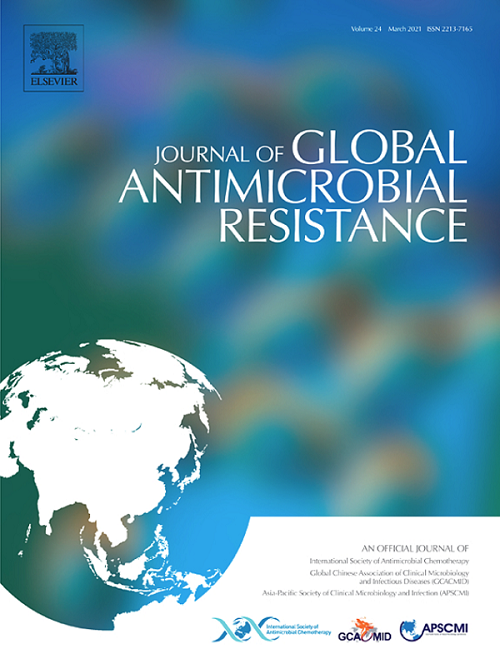老年住院患者革兰氏阴性菌尿路感染:耐药性时代的流行病学、临床特征及结局
IF 3.2
3区 医学
Q2 INFECTIOUS DISEASES
引用次数: 0
摘要
目的:尿路感染(UTI)是老年住院患者中最常见的感染之一,通常由多重耐药(MDR)微生物引起,其特点是临床结果较差。本研究旨在评估老年尿路感染住院患者的临床特征、微生物学、治疗模式和死亡率预测因素,重点关注耐多药革兰氏阴性菌(MDR- gnb)引起的感染。方法:对171例患者进行回顾性分析。收集了人口统计学、合并症、感染特征、抗菌素耐药性、治疗和结局的数据。通过单变量和多变量分析确定耐多药gnb UTI的危险因素和14天死亡率的预测因素。结果:171例患者(中位年龄:82岁)中,106例(62.0%)有导管相关UTI (CAUTI), 105例(61.4%)有医疗保健相关UTI。68.4%的病例分离出耐多药gnb。常见病原菌包括大肠杆菌(74/171,43.3%)、克雷伯氏菌(39/171,22.8%)和铜绿假单胞菌(33/171,19.3%)。其中35.1%为广谱β-内酰胺酶(ESBL)产生菌,3.7%携带肺炎克雷伯菌碳青霉烯酶(KPC), 3.0%携带金属β-内酰胺酶(MBL)。总体而言,14天死亡率为12.9%。14天死亡率的预测因素包括感染性休克、由斯华氏普罗维登菌引起的感染、由产生新德里金属β-内酰胺酶(NDM)的肺炎克雷伯菌引起的感染以及不适当的经验性抗生素治疗。结论:尿路感染对老年患者住院时间和死亡率有显著影响。在目前的情况下,在管理这些感染时必须考虑包括KPC和MBL产生在内的耐药机制。及时识别耐多药微生物感染的危险因素并优化抗微生物策略对于改善这一脆弱人群的预后至关重要。本文章由计算机程序翻译,如有差异,请以英文原文为准。
Urinary tract infections caused by Gram-negative bacteria in elderly hospitalized patients: Epidemiology, clinical features and outcomes in the era of antimicrobial resistance
Objective
Urinary tract infections (UTI) are among the most common infections in elderly hospitalized patients, often caused by multi-drug resistant (MDR) organisms and characterized by poor clinical outcomes. This study aimed to evaluate the clinical characteristics, microbiology, treatment patterns, and predictors of mortality in elderly hospitalized patients with UTI, with a focus on infections caused by MDR Gram-negative bacteria (MDR-GNB).
Methods
A retrospective analysis was conducted on 171 patients hospitalized between January 2022 and December 2023 at a large academic hospital in Siena, Italy. Data on demographics, comorbidities, infection characteristics, antimicrobial resistance, treatments, and outcomes were collected. Risk factors for MDR-GNB UTI and predictors of 14-d mortality were identified through univariable and multivariable analyses.
Results
Of 171 patients (median age: 82 y), 106 (62.0%) had a catheter-associated UTI, and 105 (61.4%) had a healthcare-associated UTI. MDR-GNB were isolated in 68.4% of cases. Common pathogens included Escherichia coli (74/171, 43.3%), Klebsiella spp. (39/171, 22.8%) and Pseudomonas aeruginosa (33/171, 19.3%). Among Enterobacterales 35.1% were Extended-spectrum β-lactamases-producers, 3.7% carried Klebsiella pneumoniae carbapenemase, and 3.0% metallo-β-lactamases. Overall, the 14-d mortality rate was 12.9%. Predictors of 14-d mortality included septic shock, infections caused by Providencia stuartii, infections caused by New Delhi metallo-β-lactamase-producing K. pneumoniae, and inappropriate empirical antibiotic therapy.
Conclusions
UTI significantly affect hospital length of stay and mortality in elderly patients. In the current context, resistance mechanisms including K. pneumoniae carbapenemase and metallo-β-lactamases production, must be considered when managing these infections. Prompt recognition of risk factors for infections caused by MDR organisms and optimized antimicrobial strategies are essential to improve outcomes in this vulnerable population.
求助全文
通过发布文献求助,成功后即可免费获取论文全文。
去求助
来源期刊

Journal of global antimicrobial resistance
INFECTIOUS DISEASES-PHARMACOLOGY & PHARMACY
CiteScore
8.70
自引率
2.20%
发文量
285
审稿时长
34 weeks
期刊介绍:
The Journal of Global Antimicrobial Resistance (JGAR) is a quarterly online journal run by an international Editorial Board that focuses on the global spread of antibiotic-resistant microbes.
JGAR is a dedicated journal for all professionals working in research, health care, the environment and animal infection control, aiming to track the resistance threat worldwide and provides a single voice devoted to antimicrobial resistance (AMR).
Featuring peer-reviewed and up to date research articles, reviews, short notes and hot topics JGAR covers the key topics related to antibacterial, antiviral, antifungal and antiparasitic resistance.
 求助内容:
求助内容: 应助结果提醒方式:
应助结果提醒方式:


